Release Date :
Reference Number :
2020-020
 HOUSEHOLDS WITH OVERSEAS FILIPINOS, OVERSEAS FILIPINO WORKERS, AND EMIGRANTS
HOUSEHOLDS WITH OVERSEAS FILIPINOS, OVERSEAS FILIPINO WORKERS, AND EMIGRANTSThe 2018 National Migration Survey (NMS) shows that 7.3 percent of total households in Davao Region have an Overseas Filipino (OF) family member, while 11.0 percent have an Overseas Filipino Worker (OFW). On the other hand, only 0.3 percent of the households in Davao Region had a family member which is an emigrant.

MIGRATION IN DAVAO REGION
The results also suggest that 40.0 percent of Filipinos are lifetime migrants, which means that 40.0 percent of Filipinos whose current area of residence are different from its area of birth. These lifetime migrants in the Philippines are dominantly comprised of females (54.43 percent) than males (45.57 percent). Meanwhile, 52.70 percent of Davaoeños are Inter-regional lifetime migrants which consist of 58.62 In-migrants and 41.38 Out-migrants. This means that 58.62 percent of Davaoeños are moving to another part of the region while 41.38 percent are moving out of the region.

The survey reveals that the National Capital Region (NCR), CALABARZON, Central Luzon, Bicol Region, and Central Visayas were the top five leading destination of out-migrants, while the top five leading destination for in-migrants are National Capital Region (NCR), CALABARZON, Eastern Visayas, Bicol Region, and Davao Region. In Davao region, 6.7 percent of the respondents are internal migrant which means that 6.7 of the respondents from Davao region are moving to another region, province, city/municipality (see Figure 4), while 4.7 percent are international migrants which means that 4.7 percent of the respondents are moving from one state or territory to another (see Figure 5).
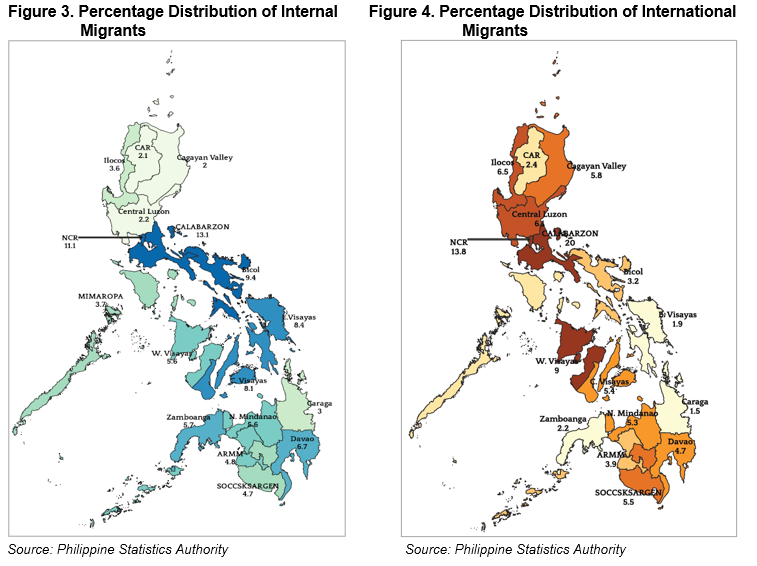
Figure 5 shows that 5.3 percent of the respondents in Davao Region had their first international move in the past five years, while 24.0 percent of the respondents had their last international move in the past five years.
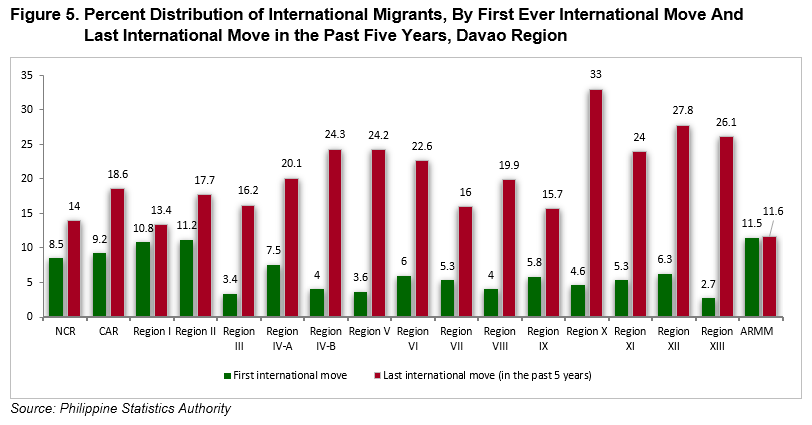
MIGRATION NETWORK
Presented in Figure 6 is the percentage distribution of international migrant’s networks in their destination country. The figure shows that among the migrants from Davao Region, 27.9 percent responded that they have a relative as their main network in the destination country. It was revealed that 9.8 percent have friends in their destination country, while only 3.2 percent answered that they have relatives and friends. On the contrary, more than half (59.1%) of migrants from Davao region do not have relatives or friends in their place of destination.
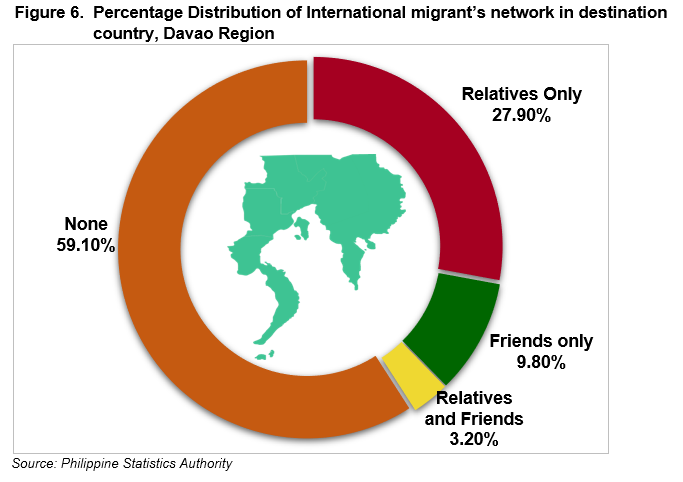
RETURN MIGRATION
Figure 7 shows that 44.0 percent of international migrants from the Davao Region experienced difficulties on their return. Nearly 64.8 percent of returning migrants responded that they had difficulty finding any job, 21.6 percent had difficulty establishing a business, 3.6 percent experienced difficulty finding employment that are in line with skills and social reintegration. Meanwhile, 1.4 percent encountered mismatch with skills acquired abroad with available jobs in the Philippines, while 1.0 percent had Security Issues.
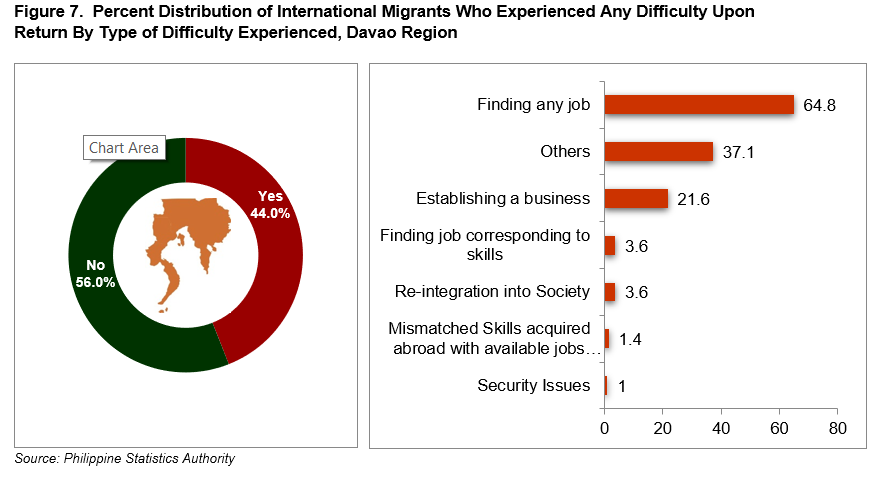
MIGRATION INTENTIONS
The results of 2018 NMS show that 16.0 percent of Davaoeños intend to migrate or move to another country in the next five years, while majority of Davaoeños don’t have any plans to move to another country in the next five years (shown in figure 8). Moreover, 67.23 percent who intend to migrate in the next five years are female and only 32.77 percent are male.
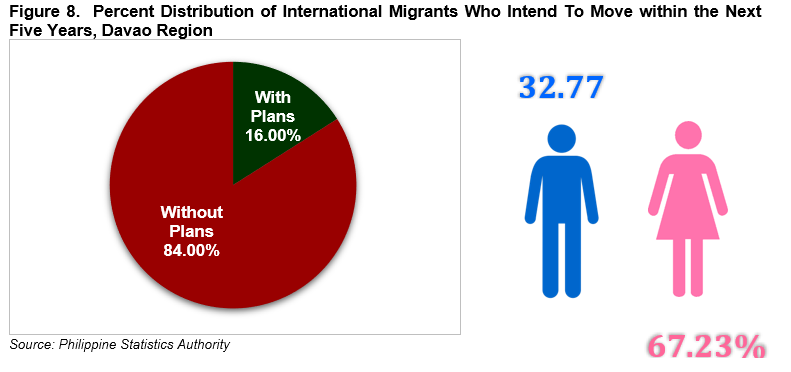
Figure 9 reveals that 31 percent of the respondents who intend to move within the next five years were with educational attainment of less than high school, 32 percent were high school level, and 37 percent were some college level.
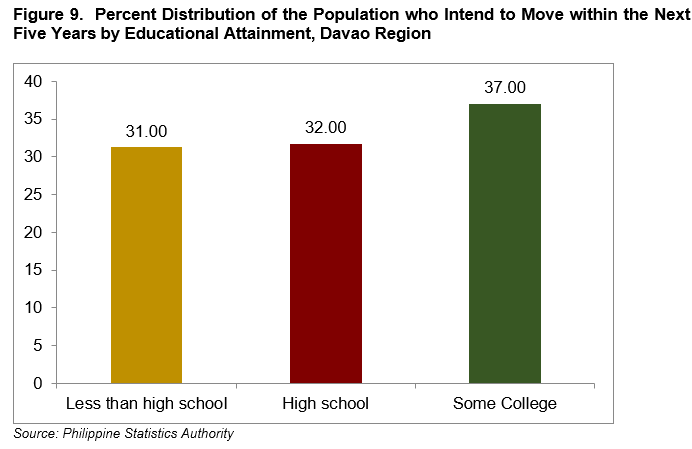
Approved for Release:
PEPITO D. AMOYEN
(Chief Statistical Specialist)
Officer-In-Charge
PSA- RSSO 11
